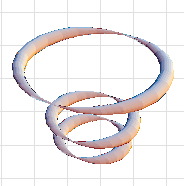
These studies developed around a clinical study that examined the changes in blood flow in the vertebral arteries when an individual's neck was taken into a series of positions that are generally used to test for a susceptibility to potential damage if the upper cervical spine is mobilized or manipulated. The findings in that study were to some extent unexpected, in that most of the so-called vertebral artery stress tests did not, in fact, stress the vertebral artery.
These observations led us to examine the manner in which the upper cervical spine moved, based upon its anatomy. From those observations, the consequences for the vertebral artery were explored by assuming that it was like an elastic tube that is stretched and distorted by the rotation of its ends in the same manner as the vertebral artery is distorted by rotation in the atlanto-axial joint. These studies are presented in the following links.
| Brief Summaries of the Essays This essay is a series of brief summaries of the other essays in this section. Each problem is presented in a very brief introduction, the mode of analysis outlined, and the main conclusions summarized. |
|
| A Model of the Upper Cervical Assembly [ Word | PDF ] This essay examines the anatomy of the upper cervical spine and develops a simple model that encapsulates that anatomy in such a way as to deduce the quantitative character of movements in the atlanto-occipital and the atlanto-axial joints. |
|
| Response to Position [ Word | PDF ] This is an analysis of the changes in blood flow in the vertebral arteries, as revealed by Doppler ultrasound, when the head and neck of individuals are placed in the positions that are generally used to stress test the vertebral arteries. |
|
| Response to Differences in Technique [ Word | PDF ] This is an analysis of a second set of experiments that examined the changes in blood flow in the vertebral arteries, as revealed by Doppler ultrasound, when the head and neck of individuals are placed in the positions that are generally used to stress test the vertebral arteries. However, different therapists were performing the premanipulative holds. |
|
| Waveform Analysis [ Word | PDF ] One of the problems that arises when one is using Doppler ultrasound to measure blood flow is that the measured variable is blood flow velocity, rather than blood flow volume. This essay examines a number of lines of evidence from the clinical study that indicate that the profiles seen are valid indices of the volumes of blood. |
|
| Vertebral Artery Strain [ Word | PDF ] The first extension of the model of the upper cervical spine is the calculation of the strains induced in the vertebral artery with lateral rotation in the atlanto-axial joint when the atlas rotates upon the odontoid process of the axis. The vertebral artery is modeled as an elastic tube that is fixed at its ends as the vertebral artery is fixed in the transverse foraminae of the atlas and axis. |
|
| Flow in a Strained Vertebral Artery [ Word | PDF ] Given the strains computed in the previous essay, one can examine how fluid flow through the strained tube would be affected, assuming laminar flow. In this essay the calculations are carried out and the dependence of blood flow on the angular excursion of the atlas upon the axis is determined. |
|
| Why Sideflexion? The Role of the Alar Ligament [ Word | PDF ] The most striking observation in the clinical study was that placing the neck in the pre-manipulative hold preparatory to a rotatory manipulation at the C1/C2 joint was by far the most effective stress test for the vertebral artery. This essay looks at how the alar ligament controls the amount of rotation in the atlanto-axial joint, contingent upon the concurrent movement in the atlanto-occipital joint. |






